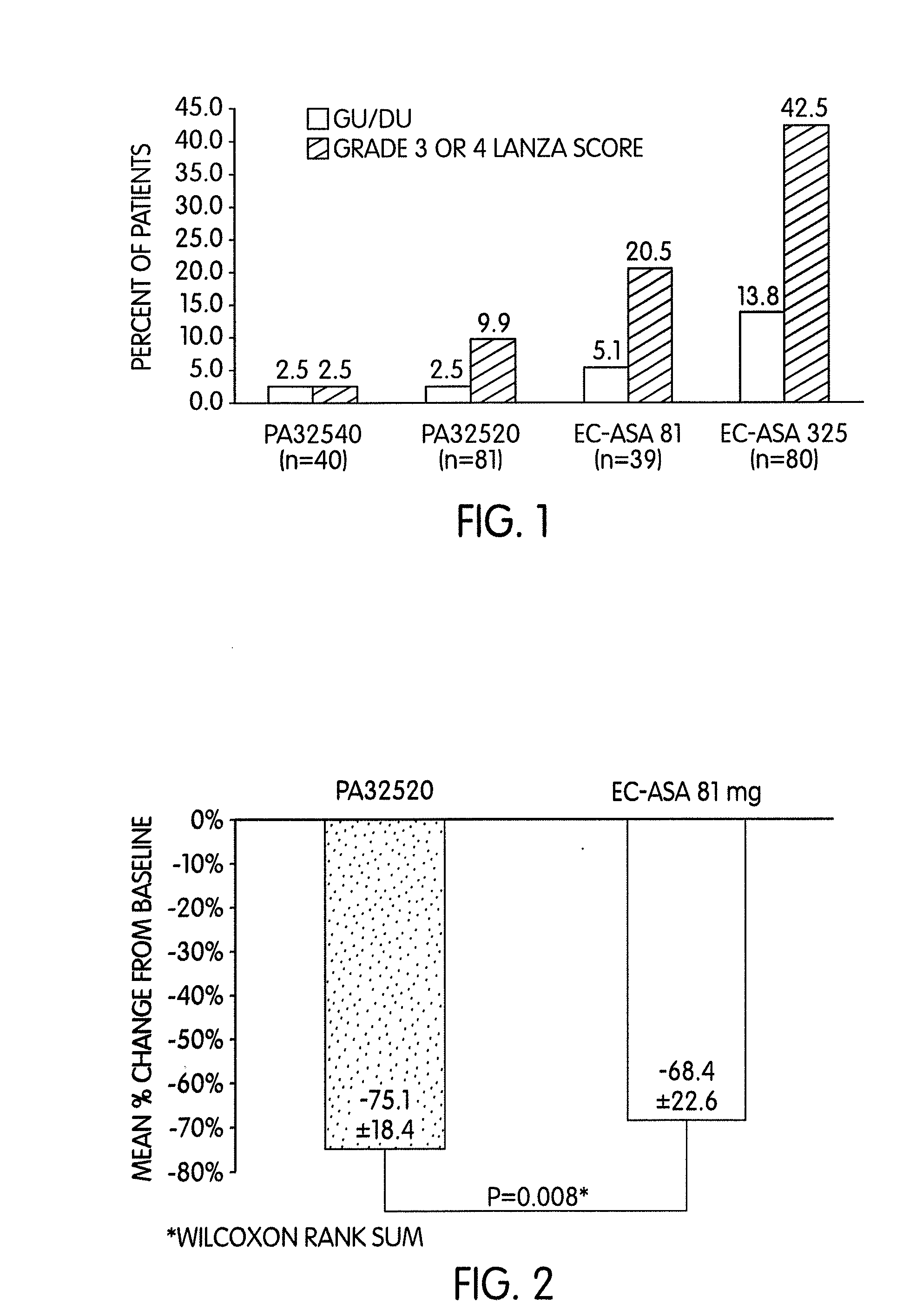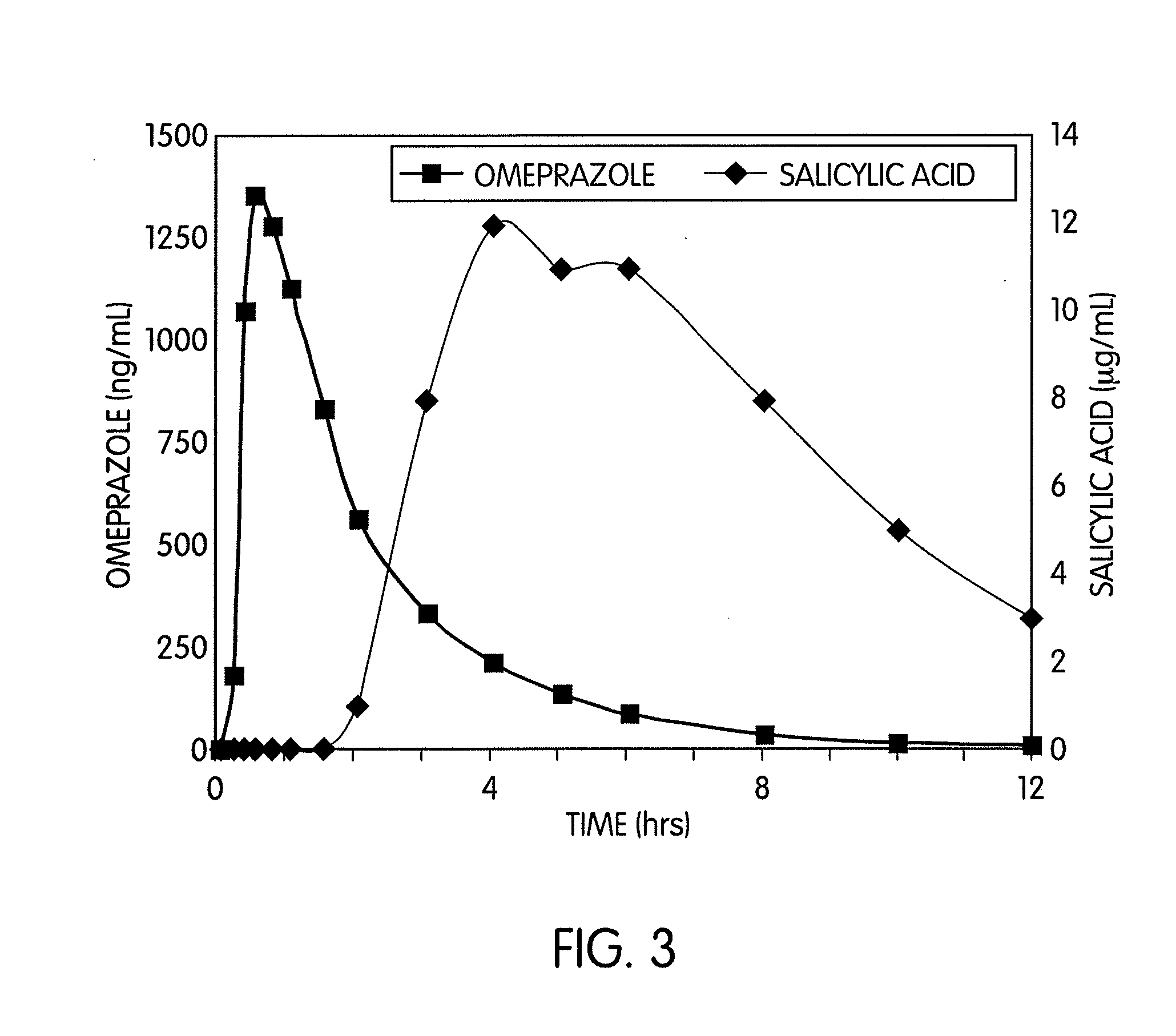Method for treating a patient in need of aspirin therapy
a technology for aspirin and patients, applied in the direction of biocide, cardiovascular disorders, drug compositions, etc., can solve the problems of acid having the ability to impair normal hemostasis and healing, the risk of ulceration and ulceration is substantial, and the use of acid is easy to increase with time, so as to reduce the risk and reduce the risk
- Summary
- Abstract
- Description
- Claims
- Application Information
AI Technical Summary
Benefits of technology
Problems solved by technology
Method used
Image
Examples
example 1
Three Phase I, 4-Week Endoscopic Studies on PA32520 (Single-Tablet of EC-ASA 325 mg+IR Omeprazole 20 mg) and PA32540 (Single-Tablet of EC-ASA 325 mg+IR Omeprazole 40 mg), Showing a Decreased Risk of Gastroduodenal Mucosal Injury
[0054]A total of 240 healthy volunteers with normal baseline endoscopy (Lanza score 0) participated in three Phase I, single-blind, randomized, controlled studies to evaluate via endoscopy the gastroduodenal effects of a fixed combination tablet of delayed release (“DR”) aspirin (“ASA”) 325 mg and immediate release (“IR”) omeprozole (20 or 40 mg). Two studies evaluated PA32520 (DR ASA 325 mg +IR omeprazole 20 mg) vs. either EC-ASA 81 mg or 325 mg. The third study compared PA32540 (DR ASA 325 mg +IR omeprazole 40 mg) with EC-ASA 325 mg. All medications were dosed once daily for 4 weeks. Endoscopy results were evaluated using 1988 Lanza scoring, which is a system that scores the severity of NSAID-induced GI tract ulcers on a scale of 0=no visible lesions, 1=1 h...
example 2
Two Phase I, 4-Week Endoscopic Studies on PA32520 (Single-Tablet of EC-ASA 325 mg+IR Omeprazole 20 mg) Shows Greater Thromboxane Suppression and Lower Upper Gastrointestinal Damage
[0057]In a randomized, single-blinded controlled Phase I study, gastroduodenal mucosal changes using an established methodology (Lanza score) and urinary 11-dehydrothromboxane (“11-dh-TXB2”) were determined in 80 healthy volunteers (mean ages 57-58 yrs) with no endoscopic evidence of gastroduodenal mucosal damage (Lanza score 0) who were treated with a daily dose of PA32520 or 81 mg EC-ASA. In a separate Phase I study (n=80), the effect of PA32520 vs. 325 mg EC-ASA alone on gastroduodenal mucosal changes was studied in 80 healthy volunteers. The primary endpoint was Lanza Grade 3 or 4 (>20 erosions / hemorrhages or ulcers) at Day 28; secondary endpoints included Grade 3 or 4 at Day 14, gastric or duodenal ulcers by Day 28, and the change from baseline in urinary 11-dh-TXB2 after 4 weeks. Study assessments we...
example 3
Four Phase 1, 4-Week Endoscopic Studies on PA32520 (Single-Tablet of EC-ASA 325 mg+IR Omeprazole 20 mg) and PA32540 (Single-Tablet of EC-ASA 325 mg+IR Omeprazole 40 mg) Show Bioequivalence to EC-ASA, Greater Thromboxane Suppression and Lower Upper Gastrointestinal Damage
[0060]Four Phase I studies with PA32520 and PA32540 evaluated bioequivalence to EC-ASA, UGI safety, and inhibition of thromboxane. The bioequivalence of aspirin from PA32540 vs. EC-ASA 325 mg / day was determined in a single-dose, open-label, crossover study in 36 healthy volunteers (mean age 32 yrs). In three single-blind, multiple-dose, randomized studies, healthy adults >50 yrs with normal baseline endoscopy (Lanza score 0) were treated with either PA32520, PA32540, EC-ASA 81 mg / day or EC-ASA 325 mg / day. For PA32520 vs. EC-ASA 81 mg / day, 11-dh-TXB2 was also measured. The endpoints were the proportion of subjects with Grade 3 or 4 Lanza scores at Day 14, the proportion of subjects with Grade 3 or 4 Lanza scores at Da...
PUM
| Property | Measurement | Unit |
|---|---|---|
| temperature | aaaaa | aaaaa |
| elimination half life | aaaaa | aaaaa |
| pH | aaaaa | aaaaa |
Abstract
Description
Claims
Application Information
 Login to View More
Login to View More - R&D
- Intellectual Property
- Life Sciences
- Materials
- Tech Scout
- Unparalleled Data Quality
- Higher Quality Content
- 60% Fewer Hallucinations
Browse by: Latest US Patents, China's latest patents, Technical Efficacy Thesaurus, Application Domain, Technology Topic, Popular Technical Reports.
© 2025 PatSnap. All rights reserved.Legal|Privacy policy|Modern Slavery Act Transparency Statement|Sitemap|About US| Contact US: help@patsnap.com


